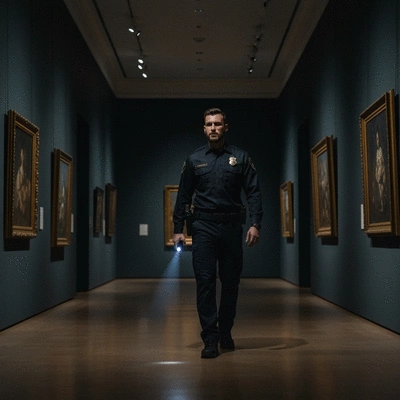Antwerp's Unforgettable Diamond Heist
By Julian Kincaid / Oct 08
What drives a person to orchestrate an audacious heist? The Isabella Stewart Gardner Museum heist is not just a theft; it’s a complex tale of ambition, deception, and the pursuit of cultural treasures. Let’s explore the key lessons and insights from this fascinating case.
The Isabella Stewart Gardner Museum heist remains an unsolved mystery. Below, we break down the critical events and the enduring legacy of this audacious art theft.
10:00 PM
Imposters enter, posing as officers.
10:15 PM
Guards subdued, thieves roam freely.
10:30 PM
Thieves enter the Dutch Room.
11:21 PM
Escape with 13 pieces of art.
Advanced Surveillance
Cutting-edge technology to monitor exhibits.
Enhanced Employee Training
Staff trained for suspicious behavior & emergencies.
Law Enforcement Collaboration
Partnerships for robust action plans.
Insurance & Recovery Plans
Diligence in collection protection and recovery.
The audacious heist that unfolded on March 18, 1990, at the Isabella Stewart Gardner Museum remains one of the most notorious thefts in art history. In just 81 minutes, the thieves executed a meticulously planned operation that not only challenged museum security but also stunned the art world. As a true crime writer and historian, I find myself drawn to the details of this case, which is a captivating mix of ambition, deception, and intrigue.
On that fateful night, two men dressed as police officers entered the museum, claiming to respond to a disturbance. Once inside, they subdued the guards, binding them with duct tape, and set about their heist with alarming efficiency. Here’s a quick look at how the plan unfolded:
The efficiency and planning involved were remarkable, showcasing the audacity of the criminals and their understanding of the museum’s layout. But what makes this heist even more compelling are the pieces that were stolen, each carrying its own story and significance.
Among the stolen works, two pieces stand out for their immense value and cultural significance: Rembrandt’s *The Storm on the Sea of Galilee* and Vermeer’s *The Concert*. These works not only reflect the artists’ mastery but also their profound impact on art history. Here's a closer look at these key pieces:
The loss of these masterpieces not only robbed the museum and its visitors of their beauty but also left a gaping hole in the art world. The heist serves as a reminder of the vulnerability of even the most prestigious institutions.
As the investigation unfolded, several key figures emerged, each with their own connection to the heist. Among them were:
Each of these individuals adds layers to the mystery surrounding the case, and their stories intertwine with the broader narrative of crime and ambition. As we piece together the events of that night, we not only explore the heist itself but also the human stories behind it.
The pursuit of justice for the Isabella Stewart Gardner Museum heist continues to captivate the public. The enduring quest to recover the stolen artworks and bring those responsible to justice has sparked countless theories and investigations. As a passionate true crime writer, I will delve deeper into the ongoing efforts to unravel this mystery in the sections that follow.
The Isabella Stewart Gardner Museum heist is considered the largest property theft in U.S. history, with an estimated value of over $500 million in stolen art. Despite extensive investigations, none of the artworks have been recovered, making this case a haunting mystery that continues to intrigue both art lovers and crime enthusiasts.
The Isabella Stewart Gardner Museum heist is not just a tale of stolen art; it is a profound reminder of the vulnerabilities within our cultural institutions. As I delve into this story through The Heist Chronicles, I uncover how this historic theft has reshaped not only the practices of museums but the entire landscape of art preservation.
In the wake of the heist, museums around the world have implemented stringent security measures to protect their invaluable collections, ensuring that history does not repeat itself. This event has sparked a global conversation about the need for enhanced vigilance and innovative strategies in the realm of art security.
One of the most significant legacies of the Isabella Stewart Gardner Museum heist is the heightened focus on security protocols. Museums have learned valuable lessons that influence their operations today. Here are some key measures adopted post-heist:
These changes reflect a broader commitment to protecting our cultural heritage from the significant implications that art theft can have on society.
Art crime, including theft, not only robs society of its cultural artifacts but also disrupts the narrative of our shared history. The Isabella Stewart Gardner Museum heist is a prime example of how art theft can resonate beyond the immediate loss, affecting cultural heritage on a global scale. This incident serves as a critical case study in understanding the far-reaching impacts of art theft:
As I reflect on these consequences, I am reminded of the profound responsibility we all share in preserving art and culture for future generations.
The mystery surrounding the Isabella Stewart Gardner Museum heist continues to linger, and there is still hope for the recovery of the stolen artworks. I urge anyone with information to come forward and assist in bringing closure to this case. Your insights could be invaluable in connecting the dots that have remained elusive for years.
Stay informed about updates on the investigation and engage with discussions in the art community. By sharing knowledge and remaining vigilant, we can collectively contribute to the recovery of these lost treasures. Join me at The Heist Chronicles as we continue to explore this captivating story and work towards a resolution!
Here is a quick recap of the important points discussed in the article:



 Antwerp's Unforgettable Diamond Heist
Reflecting on the audacious Antwerp Diamond Heist, consider the intricate balance between security a
Antwerp's Unforgettable Diamond Heist
Reflecting on the audacious Antwerp Diamond Heist, consider the intricate balance between security a
 Brink's-Mat Robbery: A Notable Heist
The Brink's-Mat robbery is a captivating tale of audacity, meticulous planning, and the intricate we
Brink's-Mat Robbery: A Notable Heist
The Brink's-Mat robbery is a captivating tale of audacity, meticulous planning, and the intricate we
 Inside the Graff Diamonds Heist
What drives a group of thieves to orchestrate a heist worth millions? As we unravel the audacious Gr
Inside the Graff Diamonds Heist
What drives a group of thieves to orchestrate a heist worth millions? As we unravel the audacious Gr